#hedkult
Explore tagged Tumblr posts
Text
youtube
"[B]ut their dead bodies had told their secrets in dreams to the first men, who formed a cult which had never died..."
Because it's that time again.
5 notes
·
View notes
Text
This arrived today!
So, of course this arrived in Hanging Town on a Wednesday. No. 22 of 72 of the limited Fine Editions of GOETIC ATAVISMS has arrived in my grubby little hands and look, both Standard Hardback and Paperback will contain the words of Frater's Acher & UD & I and the art of Jose Sabogal, so while folks won't get the slipcase, or binding, one can see how awesome the art is.
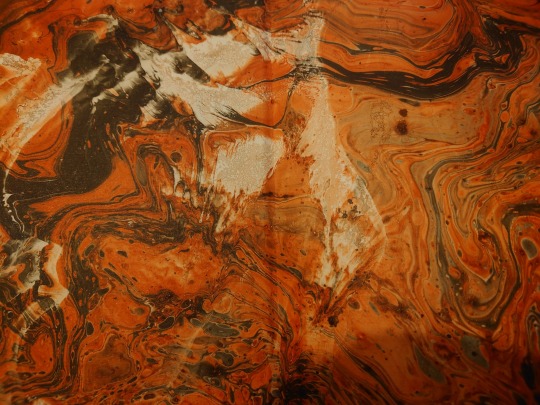


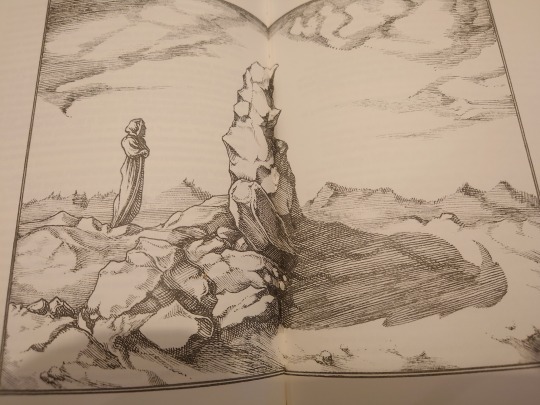

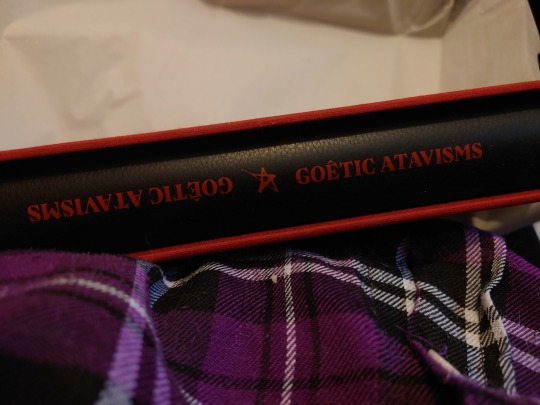
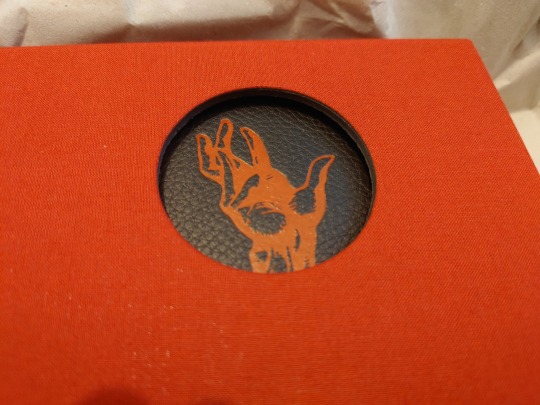
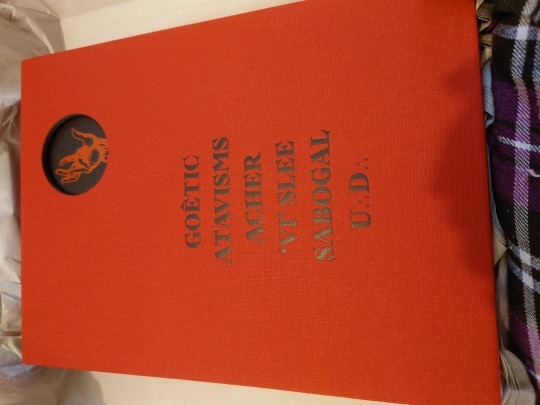
14 notes
·
View notes
Note
In light of yesterdays coronation, I think we should make you the anti-monarch of albion, and anoint you by the unbroken power of the headkvlt retinue/holy spirit? I like the idea of having a bearded bardic madman as a figure of antiauthority. You could even bring back the deerkult, then promptly antiabdicate as the horned quadrupeds emerge like a sea of holy light from the primal cavernous groves and stangs, standing stones to restore order. Or something. You seem very qualified, my two cents.
Heh. I'm no leader. That said: heavy is the head that wears the crown - it's why we cut it off. Prophecy comes best from the severed head/headless
12 notes
·
View notes
Link
"They were fearsome warriors who cut off the heads of their enemies and displayed them for all to see, bringing them back from battle hanging around their horses’ necks. But now research has confirmed that the Gauls did not merely sever the heads of their foes, they appear to have embalmed them to boot.
Experts say they have found traces of conifer resins on the remains of skulls discovered at the iron age settlement of Le Cailar in the south of France – a discovery they say backs up ancient reports that the Celtic Gauls preserved their grisly trophies.
“In fact the ancient texts told about us the head [being] embalmed with cedar oil … thanks to our chemical analysis we know that this information is right,” said Réjane Roure, co-author of the study from Paul Valéry University of Montpellier.
Previous finds at other sites have included a sculpture of a mounted warrior, not only with sword and spear but a head slung around the neck of the horse, while the gruesome practice is also noted in a number of ancient texts, and supported by discoveries of human skulls with marks of decapitation, and even nails inside them."
27 notes
·
View notes
Photo

PROOF OF LIFE 26TH NOVEMBER 2017 Looking like a Certain Kind of Severed Head.
23 notes
·
View notes
Note
Hi! I'm not the anon in the last ask about the hedkult, but funnily enough I've been relatively recently been reading a lot on the headless rite and have been going through various subjects and rabbit holes related to the matter and I was wondering if you had any thoughts on which translation to use or advice generally on perforling the rite? I've read some of what you've said about it and I'd love to read more if you've talked about tour experiences before. Thank you very much for reading :)
For some reason, this ask didn’t show up for me, and I don’t remember the hedkult ask, so sorry about that. 2020 I guess. Translation-wise? Betz. Always Betz
0 notes
Note
Good Eve, hope you are in well health. So I was wondering, about hedkult in its relation to bees, or insects. Actually creativity too. In a nutshell I was joking around with a non binary friend about 'enby' can sound like 'en-bee' and then realized a large amount of bees have been appearing in various contexts as I've been doing the headless rite. So I thought of hedkult, and you. So here I am. On top of that, im also a shintoist and the more well known lore 1/2
You may want to resend and actual question/the 2nd ask - looks like Tumblr ate it, sorry!
0 notes
Text
Think I'm kidding? See the latest video
Cheremisin and Zaporozhchenko (1999), following the methodology of Georges Dumézil, attempt to trace parallels in Germanic mythology (Odin and the mead of poetry, the eagle stealing golden apples of eternal youth). They hypothesize that all these stories, Germanic, Scythian, and Greek, reflect a Proto-Indo-European belief about the monsters guarding the entrance to the otherworld, who engage in battles with the birds conveying the souls of the newly dead to the otherworld and returning with a variety of precious gifts symbolizing new life.
youtube
The Arimaspi Since antiquity, the tales of the Arimaspi have graced the annals of lore. A clandestine tribe of one-eyed beings, Gryphon hunters, unyielding in their will. Once held in awe and respect, their existence is s shrouded in whispers and speculation. The Arimaspi manipulate Fate itself, steering the world to dark and unknown ends.
Z&A out here plumbing the Scythian Hyperborean One-Eyed stuff is smack dab in my mythological and sychronistic wheelhouse and I am not kidding
youtube
19 notes
·
View notes
Note
What is an odinsman?
Odinsman (n): A neologism for a follower, honourer, or worshipper of the being/deity who goes under the byname Óðinn (anglicized as Odin) in Norse myth. Often referring to one who identifies as male, though sometimes used gender-neutrally depending on personal taste.The term often refers to those for whom the relationship is especially meaningful, including those where he is the primary object of veneration and cultus (usually amongst others in a polytheistic context, but sometimes henotheistically). May also indicate one who has sworn an oath (but not necessarily )to follow that god, or is connected by some form of relationship which is integral to the life and practice of an individual.Gender-differential terms may also include Odinswoman, or Odinsperson.It’s a term I use to distance myself from the somewhat fraught term of “Odinist” which has frequently been used with racist or white supremacist connotations, whilst still expressing my relationship to Odin.What is that relationship? Somewhere between Grandfather-as-ancestor, mentor, partner in crime, role-model ( the latter which I acknowledge as deeply...problematic, but hey, he’s the Ur-Wizard) boss, leader.He’s the Captain.captain (n.)late 14c., capitayn, "a leader, chief, one who stands at the head of others," from Old French capitaine "captain, leader," from Late Latin capitaneus "chief," noun use of adjective capitaneus "prominent, chief," from Latin caput (genitive capitis) "head" (from PIE root *kaput- "head").He’s the Head Man. He’s the Terrible, Awe-inspiring One, who sings and screams the Mysteries of the queer and the strange and the dead; who whispers in my marrow and makes my veins and arteries burst into the corpse-light of blood and honey, the ichor of burnished gold which lets poets grant immortality to heroes.He’s the one who sends me Down-and-Into the Mound, and Calls Me Up to soar, to hunt and devour sublime and awful Mysteries as I bleed.(It’s not only seeresses he does it to)
23 notes
·
View notes
Text
What god?
What god Does now trespass on the fringes Of awareness?
Sly extension of foot So fleet and strong of sinew Disturbs the garden
Steps light in heated darkness Glides through viridian perfumes Seeking scarlet flowers
Soothing jaguar roar Into the rumble of pleased thunder As the hunters entwine themselves
About his calves Full of feline grace and serpent’s wisdom Fang forever embedded in his heel
What god has such sight? What god has such steps That brings forth from such soil all unknown? Coming forth aye Forth and following With mouth aflame
The Nameless God of Names - Akephalos! He who stirs the magician’s oracle Enlivens the anointed In frenzied baptism The severed head With gory ashen locks a-writhing Cries out forever: AŌTH ABRAŌTH BASYM ISAK SABAŌTH IAŌ.
#hedkult#stele of jeu#akephalos#yes the headless one is a syncretic god#a magician's god#not one for worship though
57 notes
·
View notes
Link
And all should cry, Beware! Beware! His flashing eyes, his floating hair! Weave a circle round him thrice, And close your eyes with holy dread For he on honey-dew hath fed, And drunk the milk of Paradise.–Kubla Khan, Samuel Taylor Coleridge
In a way, it’s fitting that my first post after the blog’s return from being hacked is written under the influence of morphine. After all, mankind has enjoyed a close, if somewhat fraught relationship with the poppy, for thousands of years.
Whether that be out in Afghanistan, China, the opium dens of Britain and America, or even the Romantic poets and the Victorians with their laudanum and other preparations, it’s been around for a long, long time. It’s in my particular system for health reasons which I shan’t go into here, but suffice to say the last few months have not been particularly pleasant.
Why do I bring this up? Possibly, to explain the nature of this post, and to ask for some forgiveness if yr. humble correspondent strays from the paths of relevancy. Yet also to mention that, though it took me weeks to read, my conciousness ebbing and flowing, my attention wavering from print after only a few moments like the proverbial stoned ape, I really enjoyed Gordon’s first book.
In case you didn’t know, that’s Star.Ships: A Prehistory Of The Spirits and it’s really good. Like, 2001-monolith good. Somehow, Gordon’s managed to distil down a slab of something which, if you approach it with an open mind, might very well give you some new ground to recontextualise myth amd magic. Let it into your brain and see where you end up.
But this isn’t a review. No, this is – actually I don’t know what this is, but I was occasionally nicknamed Coleridge at university, so you’ll have to forgive my fugue and put up with a sort of juxtapositional quotefest:
WE ARE THE WITCHCRAFT. We are the oldest organization in the world. When man was born, we were. We sang the first cradle song. We healed the first wound, we comforted the first terror. We were the Guardians against the Darkness, the Helpers on the Left Hand Side. Rock drawings in the Pyrenees remember us, and little clay images, made for an old purpose when the world was new. Our hand was on the old stone circles, the monolith, the dolmen, and the druid oak. We sang the first hunting songs, we made the first crops to grow; when man stood naked before the Powers that made him, we sang the first chant of terror and wonder. We wooed among the Pyramids, watched Egypt rise and fall, ruled for a space in Chaldea and Babylon, the Magian Kings. We sat among the secret assemblies of Israel, and danced the wild and stately dances in the sacred groves of Greece. (John Whiteside Parsons, We Are The Witchcraft)
In which my morphine addled brain goes on a ramble on my other longform blog,through themes triggered by @gordonwhite of Rune Soup's book, Jack Parsons and other things. If I wasn't so out of it, and this hadn't taken days to write I would have pulled in more from JSK’s GEOSOPHIA as well.
32 notes
·
View notes
Quote
In a compelling example of the sort of non-human logic described at the opening of this chapter, we have the Headless Rite. Straddling the modern and supremely ancient world, it is an invocation of an asterism that led tribes across the globe for tens of millennia, that had ‘headless’ star temples raised in honour of it and its consort where hunters would feast, take drugs and learn the skills of grain cultivation, that became associated with stellar immortality (and still grain) to such an extent that great stone maps of it were built upon the earth. In a transparently shamanic survival, alignment with this asterism conferred kingship over the realm of the spirits. So potent was the initiatory power of headlessness – to have one’s head in another realm – that it has survived into two of the three great religions of the Near East in the form of John the Baptist, who ‘initiates’ Christ and thus brings that same promise of victory over death back down to earth. How or why could you possibly improve on that? There is no need to toddle off to Devon for a ‘shamanic initiation’ weekend. The blood spilled at Göbekli Tepe still stains the Headless Rite’s words of power. Speak them.
Star.Ships: A Prehistory Of The Spirits, Gordon White
42 notes
·
View notes
Quote
Remarkably, there are also legends of ‘The Head’ or head worship at Harran. When an earlier Abbasid Caliph, al-Ma’mun, passed through Harran, he accused the Harranians of being ‘Adherents of the Head. ’ This apparently refers to practices performed on the head of a man who resembled ‘Utarid (Mercury). A contemporaneous Arab historian describes what he believed to be the ritual associated with this head cult: the man who resembled Mercury would be placed in a vat of oil and borax until his joints relaxed. Then his head was pulled, stretching his neck. This action was performed each time Mercury was ‘at its height. ’ This head would then prophesy in tongues. We may assume such activity continued posthumously as well, as the Ghayat al-Hakim, the Picatrix, contains several rituals associated with divination using severed heads, that bear a significant resemblance to these Harranian practices. The Picatrix even attributes one of these rituals to ‘a philosopher known under the name of Brahma of Brahman, who died in India. ’ There are certainly Hindu spells that require the use of a head, one even requires it to be set up in opposition to the dragon – suggesting astrological components – but then there is also simply Brahma/Abraham/Harran. Greene keenly observes that none of the accounts of ‘head-omancy’ can be taken literally as, plainly, the Caliphate would not have allowed such practices to continue. She considers them either religious propaganda – painting ‘the savages’ as human sacrificers – or symbolising some esoteric doctrine (or both).
Star.Ships: A Prehistory Of The Spirits, Gordon White
26 notes
·
View notes
Quote
The combination of the bird – most often the vulture – and the head is repeated several times throughout the entire site. During the 2012 season, a larger-than-lifesize, realistic human head in the talons of a large bird was discovered in a deep sounding trench in the main excavation area. This is an image that is well-known from Nevali Çori and is thus highly suggestive of the continuation of ‘headlessness’ and the special significance of the head from the deep Palaeolithic into the post-agricultural era. Other carved heads have been discovered in the fill of various enclosures, and are curiously evocative of some comparatively nearby cultic practices in Jericho, ‘Ain Ghazal and Tell Aswad, where human skulls were removed from corpses and given new faces made from gypsum plaster before being installed in ancestral shrines. As far back as 26,000 years ago (doubling the distance between Göbekli Tepe and us), graves where the skulls have been painted with red ochre are found. From the same era, the Gravettian graves – found across Europe – often contain headless skeletons or sometimes just skulls.
Star.Ships: A Prehistory Of The Spirits, Gordon White
49 notes
·
View notes
Note
#hedkult like what the actual fuck, though? I came across a straight-up severed heads post on a Dionysos blog Sunday. Tagged #dionysos #heads. I stared at it biliously for a minute and noped away because are you kidding me, but it's on the research list. I know it's reductionist etc but how the hell am I supposed to just be like #kosmos and chill, one needs some sort of working toolbox for sorting out one deity's pings from another's, THEY CAN'T JUST ALL SHARE THE SAME SET OF REFERENTS OMGG.
Blame the poet-singers. Be they Bacchic Orphics, German Minnesangers Norse skalds. Blame the strange foreign gods who fetter and loosen. Blame the severed head oracles and the streaming well-waters and the Ladies who hang out in lakes and burial mounds.There is a point when referrents dissolve. Where they are refreshed, and emerge anew, in new and strange forms, bearing culture while wreathed in green, covered in grave-ash. Where thorny thigh flexes high and dancing on bald mountain.Where a mouth of feathers cuts like razors and the sweating bulls and stallions are gelded. Where carrion-sweetness thickens like blood and honey in the veins and arteries of old wood.How can a severed head utter prophecy and poetry? When the head comes away from the neck, it’s over...All that’s left is the impossible. Thou soul of wine singing in its skins. the gold mead bubbling in the horn - intoxication in the very marrow,There is no #kosmos and chill. There’s ice and fire, chaos and burnished bloodlight gleaming on winedark sea.Orpheus torn asunder, raving maenads, shrieking slain-choosers winnowing the fallen, bearing them up with an eroticism that has less to do with sex and more to do with the pull of gravity. Each molecule, each atom pulled together, each galactic arm thrown out with supernovae fingers, reaching ever reaching, ever questing.
Aching for that moment of contact, that polarity; the electric arc that links heaven and earth, the biochemical leap between synapse, the gravity wave of two dying black holes, sight without sight.
There’s a time for unpicking the weave. It’s not when you’re gasping, not when you’re strangling, not when you’re so close to lifting the cup to trembling lips.There’s nectar on those orchids. Sweat and hair and taurine and sacrifice cast amidst the stars.Bear and bull, haunch and wagon.How is one supposed to...?...There is no ‘suppose’.
suppose (v.) early 14c., "to assume as the basis of argument," from Old French suposer "to assume" (13c.), probably a replacement (influenced by Old French poser "put, place") of *suppondre, from Latin supponere "put or place under; to subordinate, make subject," from sub "under" (see sub-) + ponere "put, place" (past participle positus; see position (n.)). Meaning "to admit as possible, to believe to be true" is from 1520s.
assume (v.) early 15c., assumpten "to receive up into heaven" (especially of the Virgin Mary), also assumen "to arrogate," from Latin assumere, adsumere "to take up, take to oneself, take besides, obtain in addition," from ad- "to, up" (see ad-) + sumere "to take," from sub "under" (see sub-) + emere "to take" (seeexempt (adj.)). Meaning "to suppose, to take for granted as the basis of argument" is first recorded 1590s; that of "to take or put on (an appearance, etc.)" is from c. 1600. Related: Assumed; assuming. Early past participle was assumpt. In rhetorical usage, assume expresses what the assumer postulates, often as a confessed hypothesis; presume expresses what the presumer really believes.We do not assume. It is us who are assumed.Taken, received into the starry heaven which lies below the Earth, received by those who dwell in the Mount.
receive (v.) c. 1300, from Old North French receivre (Old French recoivre) "seize, take hold of, pick up; welcome, accept," from Latin recipere "regain, take back, bring back, carry back, recover; take to oneself, take in, admit," from re- "back," though the exact sense here is obscure (see re-) + -cipere, comb. form of capere"to take" (see capable). Radio and (later) television sense is attested from 1908. Related: ReceivedWe, who wander the earth? We who have no home? Down we go. Down, down and down. Wherever we rest foot, head, body, blood, the Earth calls us back to that Primal Starry Cave. Under hollow hill and over dale. This, is where our ancestors live. Though thousands of miles from origin, from land of birth go 7 miles down, go 9, and find the centre.The centre is everywhere. The singular eye that sees all.This is khthonia.
chthonic (adj.) 1882, with suffix -ic, from Greek khthonios "of the earth, in the earth," from khthon "the earth, solid surface of the earth" (mostly poetic) from PIE root*dhghem- (cognates: Greek khamai "on the ground," first element in chameleon; also Latin humus "earth, soil," humilis "low;" Lithuanian žeme, Old Church Slavonic zemlja "earth;" Sanskrit ksam- "earth" (opposed to "sky"); Old Irish du, genitive don "place," earlier "earth").Semele daughter of Cadmus and mother of Dionysus, from Latin, from Greek Semele, a Thraco-Phrygian earth goddess, from Phrygian Zemele "mother of the earth," probably cognate with Old Church Slavonic zemlja "earth," Latin humus "earth, ground, soil" (see chthonic).
Semele (/ˈsɛməli/; Greek: Σεμέλη Semelē), in Greek mythology, daughter of the Boeotian hero Cadmus and Harmonia, was the mortal mother[1] of Dionysus by Zeus in one of his many origin myths.
Certain elements of the cult of Dionysos and Semele came from the Phrygians.[2] These were modified, expanded and elaborated by the Ionian Greek invaders and colonists. Herodotus, who gives the account of Cadmus, estimates that Semele lived sixteen hundred years before his time, or around 2000 BCE[3] In Rome, the goddess Stimula was identified as Semele.
[...]
The ruins of Gordion and Midas City prove that Phrygia had developed an advanced Bronze Age culture. This Phrygian culture interacted in a number of ways with Greek culture in various periods of history.[1]The "Great Mother", Cybele, as the Greeks and Romans knew her, was originally worshiped in the mountains of Phrygia, where she was known as "Mountain Mother". In her typical Phrygian form, she wears a long belted dress, a polos (a high cylindrical headdress), and a veil covering the whole body. The later version of Cybele was established by a pupil of Phidias, the sculptor Agoracritus, and became the image most widely adopted by Cybele's expanding following, both in the Aegean world and at Rome. It shows her humanized though still enthroned, her hand resting on an attendant lion and the other holding the tympanon, a circular frame drum, similar to a tambourine.
The Phrygians also venerated Sabazios, the sky and father-god depicted on horseback. Although the Greeks associated Sabazios with Zeus, representations of him, even at Roman times, show him as a horseman god. His conflicts with the indigenous Mother Goddess, whose creature was the Lunar Bull, may be surmised in the way that Sabazios' horse places a hoof on the head of a bull, in a Roman relief at the Museum of Fine Arts, Boston.The earliest traditions of Greek music derived from Phrygia, transmitted through the Greek colonies in Anatolia, and included the Phrygian mode, which was considered to be the warlike mode in ancient Greek music. Phrygian Midas, the king of the "golden touch", was tutored in music by Orpheus himself, according to the myth. Another musical invention that came from Phrygia was the aulos, a reed instrument with two pipes. Marsyas, the satyr who first formed the instrument using the hollowed antler of a stag, was a Phrygian follower of Cybele. He unwisely competed in music with the Olympian Apollo and inevitably lost, whereupon Apollo flayed Marsyas alive and provocatively hung his skin on Cybele's own sacred tree, a pine.Classical Greek iconography identifies the Trojan Paris as non-Greek by his Phrygian cap, which was worn by Mithras and survived into modern imagery as the "Liberty cap" of the American and French revolutionaries.
The Phrygians spoke an Indo-European language. (See Phrygian language.) Although the Phrygians adopted the alphabet originated by the Phoenicians, only a few dozen inscriptions in the Phrygian language have been found, primarily funereal, and so much of what is thought to be known of Phrygia is second-hand information from Greek sources.
[...]
Cybele (/ˈsɪbᵻliː/; Phrygian: Matar Kubileya/Kubeleya "Kubeleyan Mother", perhaps "Mountain Mother"; Lydian Kuvava; Greek: Κυβέλη Kybele, Κυβήβη Kybebe, Κύβελις Kybelis) was an originally Anatolian mother goddess; she has a possible precursor in the earliest neolithic at Çatalhöyük, where the statue of a pregnant, seated goddess was found in a granary. She is Phrygia's only known goddess, and was probably its state deity. Her Phrygian cult was adopted and adapted by Greek colonists of Asia Minor and spread from there to mainland Greece and its more distant western colonies from around the 6th century BCE.In Greece, Cybele met with a mixed reception. She was partially assimilated to aspects of the Earth-goddess Gaia, her Minoan equivalent Rhea, and the Harvest-Mother goddess Demeter. Some city-states, notably Athens, evoked her as a protector, but her most celebrated Greek rites and processions show her as an essentially foreign, exotic mystery-goddess who arrives in a lion-drawn chariot to the accompaniment of wild music, wine, and a disorderly, ecstatic following. Uniquely in Greek religion, she had a transgender or eunuch mendicant priesthood.[1] Many of her Greek cults included rites to a divine Phrygian castrate shepherd-consort Attis, who was probably a Greek invention. In Greece, Cybele is associated with mountains, town and city walls, fertile nature, and wild animals, especially lions.In Rome, Cybele was known as Magna Mater ("Great Mother"). The Roman State adopted and developed a particular form of her cult after the Sibylline oracle recommended her conscription as a key religious component in Rome's second war against Carthage. Roman mythographers reinvented her as a Trojan goddess, and thus an ancestral goddess of the Roman people by way of the Trojan prince Aeneas. With Rome's eventual hegemonyover the Mediterranean world, Romanised forms of Cybele's cults spread throughout the Roman Empire. The meaning and morality of her cults and priesthoods were topics of debate and dispute in Greek and Roman literature, and remain so in modern scholarship.
[...]
The first known Greek writer to mention a sibyl is Heraclitus, in the 5th century BC:The Sibyl, with frenzied mouth uttering things not to be laughed at, unadorned and unperfumed, yet reaches to a thousand years with her voice by aid of the god.'[5]
Walter Burkert observes that "frenzied women from whose lips the god speaks" are recorded very much earlier in the Near East, as in Mari in the second millennium and in Assyria in the first millennium".[6]Until the literary elaborations of Roman writers, sibyls were not identified by a personal name, but by names that refer to the location of their temenos, or shrine.In Pausanias, Description of Greece, the first sibyl at Delphi mentioned ("the former" [earlier]) was of great antiquity, and was thought, according to Pausanias, to have been given the name "sibyl" by the Libyans.[7] Sir James Frazer calls the text defective. The second sibyl referred to by Pausanias, and named "Herophile", seems to have been based ultimately in Samos, but visited other shrines, at Clarus. Delos and Delphi and sang there, but that at the same time, Delphi had its own sibyl.[7]James Frazer writes, in his translation and commentary on Pausanias,[8] that only two of the Greek sibyls were historical: Herophile of Erythrae, who is thought to have lived in the 8th century BC, and Phyto of Samos who lived somewhat later. He observes that the Greeks at first seemed to have known only one sibyl, and instances Heraclides Ponticus[9] as the first ancient writer to distinguish several sibyls: Heraclitus names at least three sibyls, the Phrygian, the Erythraean, and the Hellespontine.[10] The scholar David S. Potter writes, "In the late fifth century BC it does appear that 'Sibylla' was the name given to a single inspired prophetess".[11]
Currents, streams, down into the Earth, up bright from the Well..
*tags @theheadlesshashasheen, wrestling style* (Go on man, your turn)
#hedkult#aint no such thing as signal clarity when all things are signal#dionysos#the old man#black bird magic#volvano
76 notes
·
View notes
Text
Bowie Beyond The Seven
You gave us 7 New songs on your birthday, Mr. Bowie. Now, Blackstar you are beyond the 7: "Tell them the whole truth straight out. Say: 'I am the son of Earth and starry Heaven, but of Heaven is my birth: this you know yourselves. I am parched with thirst and perishing: give me quickly chill water flowing from the pool of Memory.' Assuredly the kings of the underworld take pity on you, and will themselves give you water from the spring divine; then you, when you have drunk, traverse the holy path which other initiates and bacchants tread in glory. After that you will rule amongst the other heroes." Go well, oh He Who Fell to Earth, go well as one who Knows. https://youtu.be/y-JqH1M4Y
47 notes
·
View notes